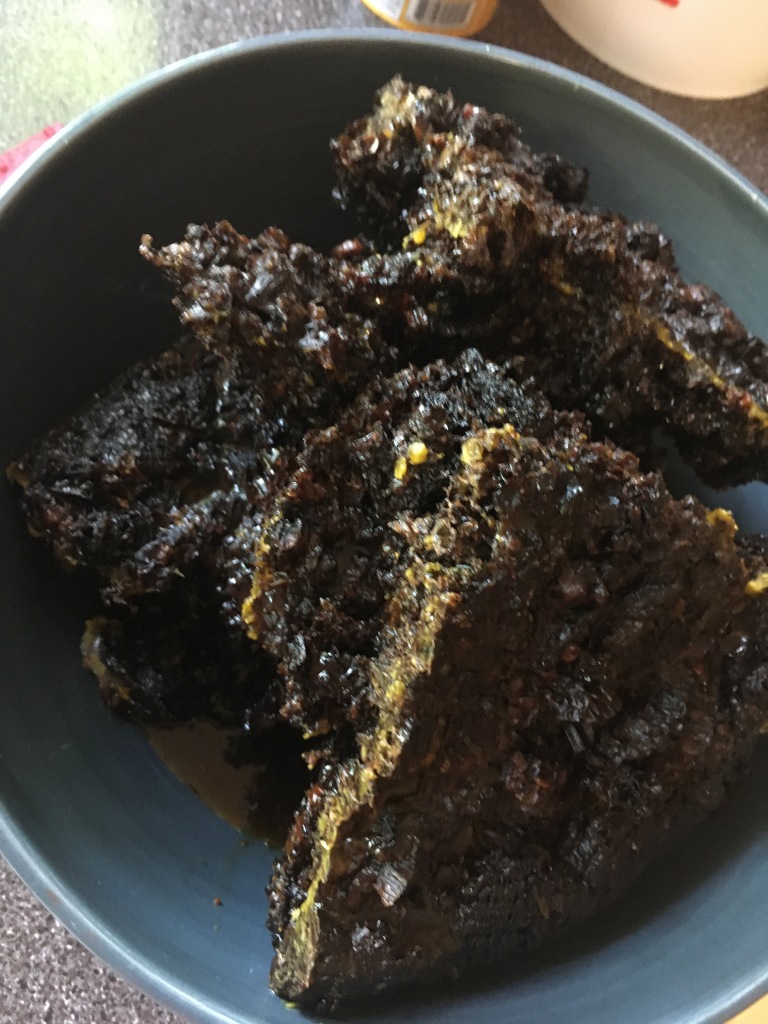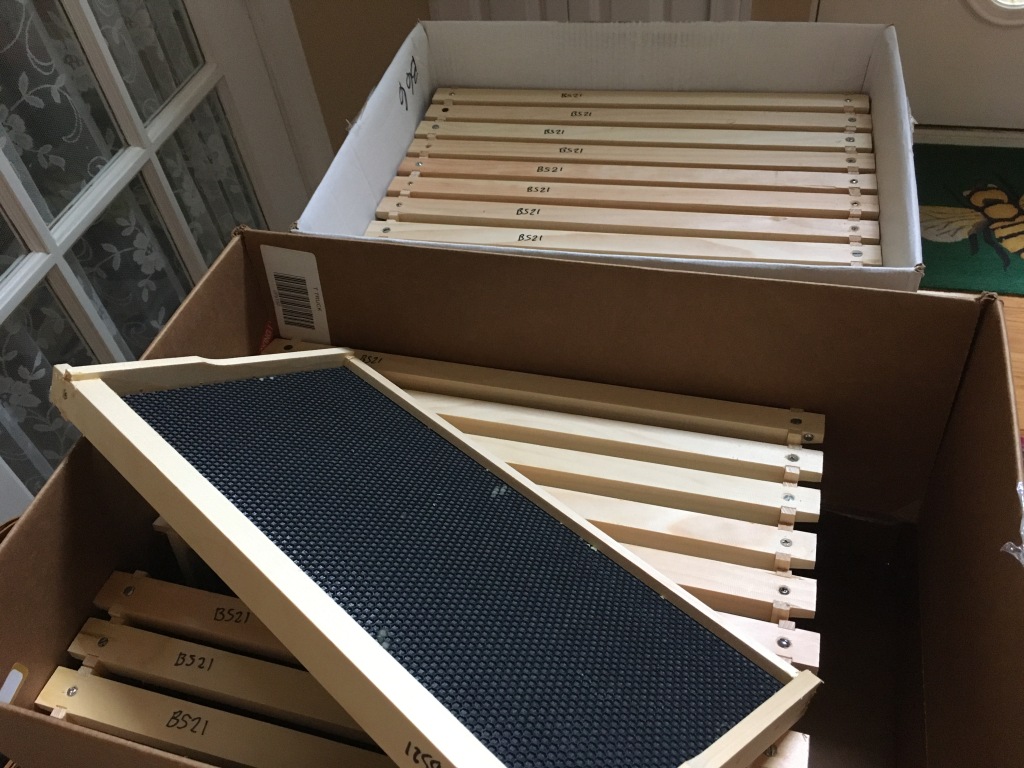Until now, I’ve not dwelled on the dark aspects of a beekeeper’s job.
No, I’m not talking about losing hives, dying queens, or even the Dreaded Varroa Destructor Mites.
I mean old beeswax.
Beeswax is a lovely substance. In its cleaner form, it smells delicious, is great for wood and has many other uses including beeswax wraps.
Unfortunately, wax that’s been reused gets old and ugly, and eventually bees refuse to use those frames.
I can’t say I blame them. The many herbicides and pesticides used in our world can accumulate in the wax and begin to affect the young bees.
Recently, we realized many of our frames have reached this state and have begun to clean and/or replace them.
Initially, we tried to extract the honey from the old frames, but it proved a lost cause. Instead we scraped them, and The Engineer powerwashed both the frames and foundation.
What to do with all that dirty, ugly wax though … hmmm, such a quandary.
Well, it turned out there was some honey, so I strained that to feed to the bees. It’s a little dark, and probably partly sugar rather than nectar, but I tasted a bit, and it’s not horrible. The Kremlin and the newest OH, Girls Split seem to like it.
I probably don’t need to remind you that honey is very, very sticky, but I’m going to anyway so you can understand the full beauty of what I was dealing with.

Straining left a dripping dark, sticky substance that stupid me decided to try to melt down.
Do NOT do this. It’s a waste of time. You get very little decent wax from a mountain of disgusting grunge.
Here’s an example of part of the mess I was working with.

At first it didn’t go too badly. I ended up getting what looked like a brand new electric roaster for $20. Using this at 200F, my first pile of wax left me with a dirty pile of … stuff … and more honey.
Still, honey is good, right? Better for the bees than pure sugar syrup, at least.
Once again, I strained the honey from the gunk, then did the same to the the other pile.
Next, I wrapped the black sludge (I’m running out of synonyms for what I cannot in good conscience call beeswax) in a cheesecloth, tied it tightly, and put it back in the roaster, with water.
Theoretically, the wax will melt and rise to the top, the gunk will stay put in the cheesecloth, and any honey that’s left will wash away with the water.
I’ve done this with cappings from when we’ve extracted, and it actually works.
Unfortunately, this stuff proved to have very little usable wax. And making matters worse, when I lifted out the second batch (while still hot, so it doesn’t get stuck in the wax), the cheesecloth slipped from my tongs and dropped back into the roaster.
Picture the first Apollo splashdown only with hot wax and honey.
Yes. It was a Big Mess, and I used every bad word I knew.
I hope the neighbors didn’t hear.

And, oh, yes, the floor.

Lessons Learned:
- It’s probably worth it to stain and even heat dark old wax for the honey.
- It is not worth wasting cheesecloth, time and effort to try to render the wax.
- An electric roaster if you can get one cheap is excellent for melting wax.
- A smarter person would have used said roaster outside for this job, perhaps in the garage, if it’s raining or you’re worried about attracting every bee in the neighborhood.
- Cleaning beeswax from a linoleum floor is possible, but not fun. I used water heated in the electric kettle, a scrubby, a towel, and a mop.
That’s how I’ll do it next time, minus the scrubbing the floor (I hope).
I’ve learned from my mistakes. But I’ll feel a lot better if you do too.
On the bright side, here are the brand new frames we’ll be using to swap out the rest of the old ones in our hives. The Engineer assembled them, and they’re waiting for me to apply a better coat of wax.
If only I could have somehow used the stuff in the roaster …

Can I offer a possible solution to spilt wax which I learned in art class after a batik accident? Paper towel on the floor on top of the wax (you can use muslin too, but it doesn’t absorb as quickly) and a sheet of baking paper on top, and a steam iron. Depending on if the floor surface can take heat (wood, stone, tile, pure wool or cottnn carpet or rugs and probably lino yes, carpet with artificial fibre and vinyl no), either put the iron down on the paper towel and jet with steam to melt the wax into the paper towel, but the baking paper prevents it sticking to the iron. If the surface isn’t as heat resistant, hover the iron above the floor surface and blast it with steam. It will take longer this way, but will work eventually. Also works with candlewax. Could you use the gunk to waterproof stitched seams in leather bags, waterproof jackets, etc, or is it simply too disgusting and hard?
LikeLike
What an excellent idea! I will have to remember for the future. Not sure if I actually have an iron, though. I’ll have to check. 😁
LikeLike
Easy to tell you’re not a quilter… I have an iron, a spare iron and a spare spare iron. Heaven forbid anything should stop the quilting process! You can also use the bottom of a heated pan, but it will lack the steam, which hellps to melt the wax without applying direct heat, so you’d need to be more cautious.
LikeLike
I thought that was probably the case. I just never iron, though I do think I have a travel one somewhere around …
LikeLike
That would do the job.
LikeLiked by 1 person
I will remember this for the future. Even melting in the garage, I’m bound to spill some.
LikeLiked by 1 person
Oh my goodness!!
LikeLiked by 1 person
It was quite the mess.
LikeLike
That second coat of wax makes a big difference on how well they draw them out. I ordered some frames from Mann Lake this year and was actually pleasantly surprised by the wax coating on them. I finally got an old hot plate that I use to melt the slum gum down outside. It does seems like it’s more trouble than it’s worth.
LikeLiked by 1 person
They definitely go right to comb that’s been double treated. 🐝
LikeLike
Pingback: Bee Clean | The Byrd and the Bees